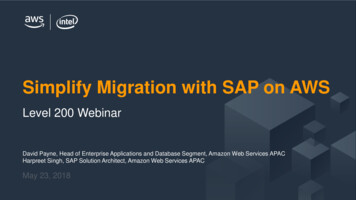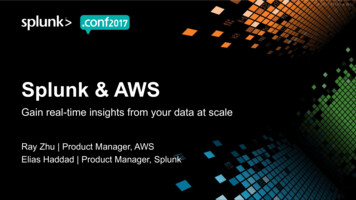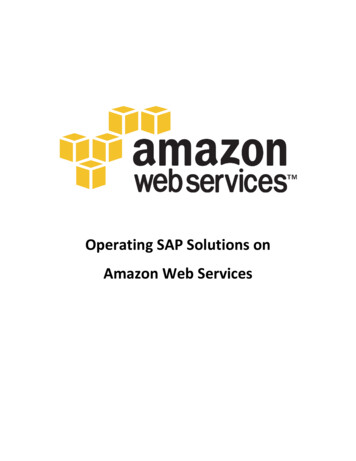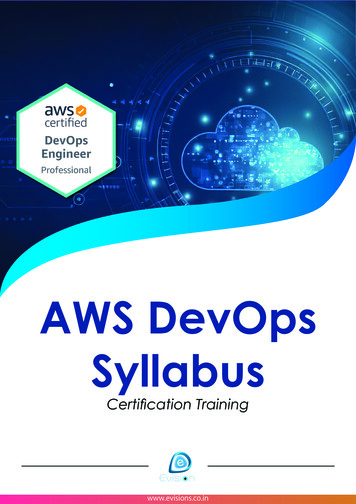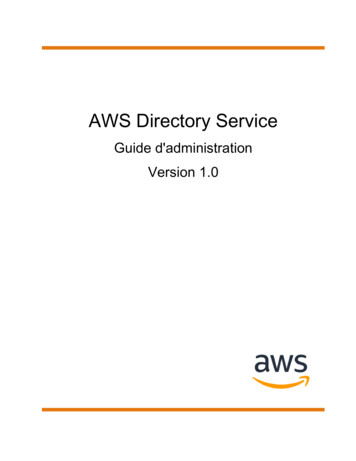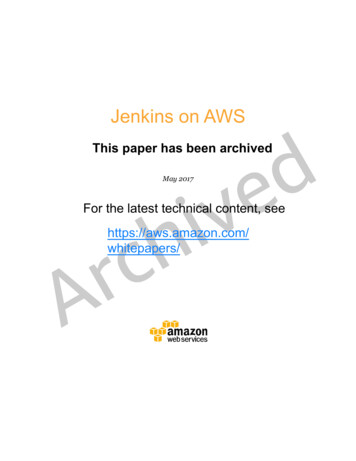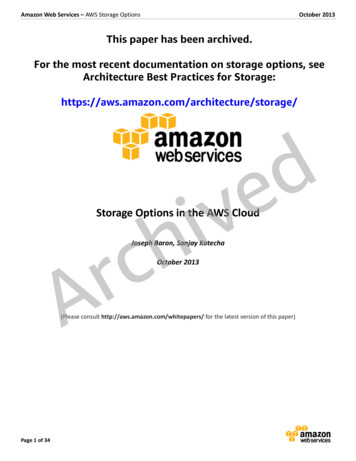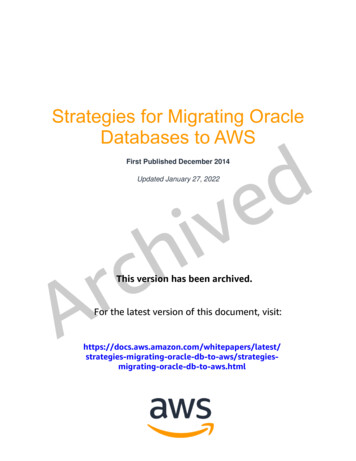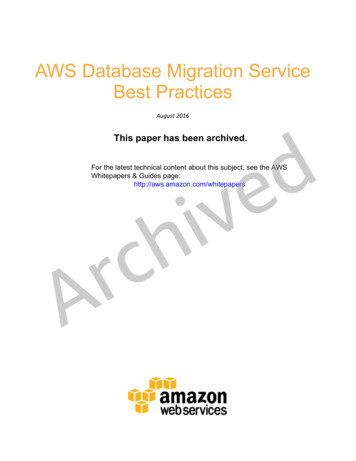
Transcription
AWS Database Migration ServiceBest PracticesAugust 2016deThis paper has been archived.For the latest technical content about this subject, see the AWSWhitepapers & Guides page:http://aws.amazon.com/whitepaperscrAvih
Amazon Web Services – AWS Database Migration Service Best PracticesAugust 2016 2016, Amazon Web Services, Inc. or its affiliates. All rights reserved.NoticesThis document is provided for informational purposes only. It represents AWS’s current productofferings and practices as of the date of issue of this document, which are subject to changewithout notice. Customers are responsible for making their own independent assessment of theinformation in this document and any use of AWS’s products or services, each of which isprovided “as is” without warranty of any kind, whether express or implied. This document doesnot create any warranties, representations, contractual commitments, conditions or assurancesfrom AWS, its affiliates, suppliers or licensors. The responsibilities and liabilities of AWS to itscustomers are controlled by AWS agreements, and this document is not part of, nor does itmodify, any agreement between AWS and its customers.vihdecrAPage 2 of 17
Amazon Web Services – AWS Database Migration Service Best PracticesAugust 2016ContentsAbstract4Introduction4Provisioning a Replication Server6Instance Class6Storage6deMulti-AZ7Source EndpointTarget Endpoint7vihTaskMigration TypeStart Task on CreateTarget Table Prep ModecrALOB ControlsEnable LoggingMonitoring Your TasksHost MetricsReplication Task MetricsTable Metrics888891010101010Performance Expectations11Increasing Performance11Load Multiple Tables in Parallel11Remove Bottlenecks on the Target11Use Multiple Tasks11Improving LOB Performance12Optimizing Change Processing12Reducing Load on Your Source System12Frequently Asked Questions13What are the main reasons for performing a database migration?Page 3 of 17713
Amazon Web Services – AWS Database Migration Service Best PracticesAugust 2016What steps does a typical migration project include?13How Much Load Will the Migration Process Add to My Source Database?14How Long Does a Typical Database Migration Take?14I’m Changing Engines–How Can I Migrate My Complete Schema?14Why Doesn’t AWS DMS Migrate My Entire Schema?14Who Can Help Me with My Database Migration Project?15deWhat Are the Main Reasons to Switch Database Engines?15How Can I Migrate from Unsupported Database Engine Versions?15When Should I NOT Use DMS?16vihWhen Should I Use a Native Replication Mechanism Instead of the DMS and the AWS SchemaConversion Tool?16What Is the Maximum Size of Database That DMS Can Handle?What if I Want to Migrate from Classic to , as many companies move database workloads to Amazon Web Services (AWS), they areoften also interested in changing their primary database engine. Most current methods formigrating databases to the cloud or switching engines require an extended outage. The AWSDatabase Migration Service helps organizations to migrate database workloads to AWS orchange database engines while minimizing any associated downtime. This paper outlines bestpractices for using AWS DMS.IntroductionAWS Database Migration Service allows you to migrate data from a source database to a targetdatabase. During a migration, the service tracks changes being made on the source database sothat they can be applied to the target database to eventually keep the two databases in sync.Although the source and target databases can be of the same engine type, they don’t need tobe. The possible types of migrations are:1. Homogenous migrations (migrations between the same engine types)2. Heterogeneous migrations (migrations between different engine types)Page 4 of 17
Amazon Web Services – AWS Database Migration Service Best PracticesAugust 2016At a high level, when using AWS DMS a user provisions a replication server, defines source andtarget endpoints, and creates a task to migrate data between the source and target databases. Atypical task consists of three major phases: the full load, the application of cached changes, andongoing replication.During the full load, data is loaded from tables on the source database to tables on the targetdatabase, eight tables at a time (the default). While the full load is in progress, changes made tothe tables that are being loaded are cached on the replication server; these are the cachedchanges. It’s important to know that the capturing of changes for a given table doesn’t beginuntil the full load for that table starts; in other words, the start of change capture for eachindividual table will be different. After the full load for a given table is complete, you can beginto apply the cached changes for that table immediately. When ALL tables are loaded, you beginto collect changes as transactions for the ongoing replication phase. After all cached changes areapplied, your tables are consistent transactionally and you move to the ongoing replicationphase, applying changes as transactions.devihUpon initial entry into the ongoing replication phase, there will be a backlog of transactionscausing some lag between the source and target databases. After working through this backlog,the system will eventually reach a steady state. At this point, when you’re ready, you can: Shut down your applications. Allow any remaining transactions to be applied to the target. Restart your applications pointing at the new target database.crAAWS DMS will create the target schema objects that are needed to perform the migration.However, AWS DMS takes a minimalist approach and creates only those objects required toefficiently migrate the data. In other words, AWS DMS will create tables, primary keys, and insome cases, unique indexes. It will not create secondary indexes, non-primary key constraints,data defaults, or other objects that are not required to efficiently migrate the data from thesource system. In most cases, when performing a migration, you will also want to migrate mostor all of the source schema. If you are performing a homogeneous migration, you canaccomplish this by using your engine’s native tools to perform a no-data export/import of theschema. If your migration is heterogeneous, you can use the AWS Schema Conversion Tool(AWS SCT) to generate a complete target schema for you.Note Any inter-table dependencies, such as foreign key constraints, must bedisabled during the “full load” and “cached change application” phases of AWSDMS processing. Also, if performance is an issue, it will be beneficial to removeor disable secondary indexes during the migration process.Page 5 of 17
Amazon Web Services – AWS Database Migration Service Best PracticesAugust 2016Provisioning a Replication ServerAWS DMS is a managed service that runs on an Amazon Elastic Compute Cloud (Amazon EC2)instance. The service connects to the source database, reads the source data, formats the datafor consumption by the target database, and loads the data into the target database. Most ofthis processing happens in memory, however, large transactions may require some buffering ondisk. Cached transactions and log files are also written to disk. The following sections describewhat you should consider when selecting your replication server.deInstance ClassSome of the smaller instance classes are sufficient for testing the service or for small migrations.If your migration involves a large number of tables, or if you intend to run multiple concurrentreplication tasks, you should consider using one of the larger instances because the serviceconsumes a fair amount of memory and CPU.vihNote T2 type instances are designed to provide moderate baselineperformance and the capability to burst to significantly higher performance, asrequired by your workload. They are intended for workloads that don't use thefull CPU often or consistently, but that occasionally need to burst. T2 instancesare well suited for general purpose workloads, such as web servers, developerenvironments, and small databases. If you’re troubleshooting a slow migrationand using a T2 instance type, look at the CPU Utilization host metric to see ifyou’re bursting over the baseline for that instance type.crAStorageDepending on the instance class, your replication server will come with either 50 GB or 100 GBof data storage. This storage is used for log files and any cached changes that are collectedduring the load. If your source system is busy or takes large transactions, or if you’re runningmultiple tasks on the replication server, you might need to increase this amount of storage.However, the default amount is usually sufficient.Note All storage volumes in AWS DMS are GP2 or General Purpose SSDs. GP2volumes come with a base performance of three I/O Operations Per Second(IOPS), with abilities to burst up to 3,000 IOPS on a credit basis. As a rule ofthumb, check the ReadIOPS and WriteIOPS metrics for the replication instanceand be sure the sum of these values does not cross the base performance forthat volume.Page 6 of 17
Amazon Web Services – AWS Database Migration Service Best PracticesAugust 2016Multi-AZSelecting a Multi-AZ instance can protect your migration from storage failures. Most migrationsare transient and not intended to run for long periods of time. If you’re using AWS DMS forongoing replication purposes, selecting a Multi-AZ instance can improve your availability shoulda storage issue occur.Source EndpointdeThe change capture process, used when replicating ongoing changes, collects changes from thedatabase logs by using the database engines native API, no client side install is required. Eachengine has specific configuration requirements for exposing this change stream to a given useraccount (for details, see the AWS Key Management Service documentation). Most enginesrequire some additional configuration to make the change data consumable in a meaningful waywithout data loss for the capture process. (For example, Oracle requires the addition ofsupplemental logging, and MySQL requires row-level bin logging.)vihNote When capturing changes from an Amazon Relational Database Service(Amazon RDS) source, ensure backups are enabled and the source is configuredto retain change logs for a sufficiently long time (usually 24 hours).crATarget EndpointWhenever possible, AWS DMS attempts to create the target schema for you, includingunderlying tables and primary keys. However, sometimes this isn’t possible. For example, whenthe target is Oracle, AWS DMS doesn’t create the target schema for security reasons. In MySQL,you have the option through extra connection parameters to have AWS DMS migrate objects tothe specified database or to have AWS DMS create each database for you as it finds thedatabase on the source.Note For the purposes of this paper, in Oracle a user and schema aresynonymous. In MySQL, schema is synonymous with database. Both SQL Serverand Postgres have a concept of database AND schema. In this paper, we’rereferring to the schema.Page 7 of 17
Amazon Web Services – AWS Database Migration Service Best PracticesAugust 2016TaskThe following section highlights common and important options to consider when creating atask.Migration Type Migrate existing data. If you can afford an outage that’s long enough to copy yourexisting data, this is a good option to choose. This option simply migrates the data fromyour source system to your target, creating tables as needed. Migrate existing data and replicate ongoing changes. This option performs a full dataload while capturing changes on the source. After the full load is complete, capturedchanges are applied to the target. Eventually, the application of changes will reach asteady state. At that point, you can shut down your applications, let the remainingchanges flow through to the target, and restart your applications to point at the target. Replicate data changes only. In some situations it may be more efficient to copy theexisting data by using a method outside of AWS DMS. For example, in a homogeneousmigration, using native export/import tools can be more efficient at loading the bulkdata. When this is the case, you can use AWS DMS to replicate changes as of the point intime at which you started your bulk load to bring and keep your source and targetsystems in sync. When replicating data changes only, you need to specify a time fromwhich AWS DMS will begin to read changes from the database change logs. It’s importantto keep these logs available on the server for a period of time to ensure AWS DMS hasaccess to these changes. This is typically achieved by keeping the logs available for 24hours (or longer) during the migration process.devihcrAStart Task on CreateBy default, AWS DMS will start your task as soon as you create it. In some situations, it’s helpfulto postpone the start of the task. For example, using the AWS Command Line Interface (AWSCLI), you may have a process that creates a task and a different process that starts the task,based on some triggering event.Target Table Prep ModeTarget table prep mode tells AWS DMS what to do with tables that already exist. If a table that isa member of a migration doesn’t yet exist on the target, AWS DMS will create the table. Bydefault, AWS DMS will drop and recreate any existing tables on the target in preparation for afull load or a reload. If you’re pre-creating your schema, set your target table prep mode totruncate, causing AWS DMS to truncate existing tables prior to load or reload. When the tablePage 8 of 17
Amazon Web Services – AWS Database Migration Service Best PracticesAugust 2016prep mode is set to do nothing, any data that exists in the target tables is left as is. This can beuseful when consolidating data from multiple systems into a single table using multiple tasks.AWS DMS performs these steps when it creates a target table: The source database column data type is converted into an intermediate AWS DMS datatype. The AWS DMS data type is converted into the target data type.deThis data type conversion is performed for both heterogeneous and homogeneous migrations.In a homogeneous migration, this data type conversion may lead to target data types notmatching source data types exactly. For example, in some situations it’s necessary to triple thesize of varchar columns to account for multi-byte characters. We recommend going through theAWS DMS documentation on source and target data types to see if all the data types you useare supported. If the resultant data types aren’t to your liking when you’re using AWS DMS tocreate your objects, you can pre-create those objects on the target database. If you do precreate some or all of your target objects, be sure to choose the truncate or do nothing optionsfor target table preparation mode.LOB ControlscrAvihDue to their unknown and sometimes large size, large objects (LOBs) require more processingand resources than standard objects. To help with tuning migrations of systems that containLOBs, AWS DMS offers the following options: Page 9 of 17Don’t include LOB columns. When this option is selected, tables that include LOBcolumns are migrated in full, however, any columns containing LOBs will be omitted.Full LOB mode. When you select full LOB mode, AWS DMS assumes no informationregarding the size of the LOB data. LOBs are migrated in full, in successive pieces, whosesize is determined by the LOB chunk size. Changing the LOB chunk size affects thememory consumption of AWS DMS; a large LOB chunk size requires more memory andprocessing. Memory is consumed per LOB, per row. If you have a table containing threeLOBs, and are moving data 1,000 rows at a time, an LOB chunk size of 32 k will require3*32*1000 96,000 k of memory for processing. Ideally, the LOB chunk size should beset to allow AWS DMS to retrieve the majority of LOBs in as few chunks as possible. Forexample, if 90 percent of your LOBs are less than 32 k, then setting the LOB chunk sizeto 32 k would be reasonable, assuming you have the memory to accommodate thesetting.Limited LOB mode. When limited LOB mode is selected, any LOBs that are larger thanmax LOB size are truncated to max LOB size and a warning is issued to the log file. Usinglimited LOB mode is almost always more efficient and faster than full LOB mode. Youcan usually query your data dictionary to determine the size of the largest LOB in atable, setting max LOB size to something slightly larger than this (don’t forget to accountfor multi-byte characters). If you have a table in which most LOBs are small, with a few
Amazon Web Services – AWS Database Migration Service Best PracticesAugust 2016large outliers, it may be a good idea to move the large LOBs into their own table and usetwo tasks to consolidate the tables on the target.LOB columns are transferred only if the source table has a primary key or a unique index onthe table. Transfer of data containing LOBs is a two-step process:1. The containing row on the target is created without the LOB data.2. The table is updated with the LOB data.The process was designed this way to accommodate the methods source database enginesuse to manage LOBs and changes to LOB data.deEnable LoggingIt’s always a good idea to enable logging because many informational and warning messages arewritten to the logs. However, be advised that you’ll incur a small charge, as the logs are madeaccessible by using Amazon CloudWatch.vihFind appropriate entries in the logs by looking for lines that start with the following: Lines starting with “E:” – ErrorsLines starting with “W:” – WarningsLines starting with “I:” – Informational messagescrAYou can use grep (on UNIX-based text editors) or search (for Windows-based text editors) to findexactly what you’re looking for in a huge task log.Monitoring Your TasksThere are several options for monitoring your tasks using the AWS DMS console.Host MetricsYou can find host metrics on your replication instances monitoring tab. Here, you can monitorwhether your replication instance is sized appropriately.Replication Task MetricsMetrics for replication tasks, including incoming and committed changes, and latency betweenthe replication host and source/target databases can be found on the task monitoring tab foreach particular task.Table MetricsIndividual table metrics can be found under the table statistics tab for each individual task.These metrics include: the number of rows loaded during the full load; the number of inserts,updates, and deletes since the task started; and the number of DDL operations since the taskstarted.Page 10 of 17
Amazon Web Services – AWS Database Migration Service Best PracticesAugust 2016Performance ExpectationsThere are a number of factors that will affect the performance of your migration: resourceavailability on the source, available network throughput, resource capacity of the replicationserver, ability of the target to ingest changes, type and distribution of source data, number ofobjects to be migrated, and so on. In our tests, we have been able to migrate a terabyte of datain approximately 12–13 hours (under “ideal” conditions). Our tests were performed using sourcedatabases running on EC2, and in Amazon RDS with target databases in RDS. Our sourcedatabases contained a representative amount of relatively evenly distributed data with a fewlarge tables containing up to 250 GB of data.deIncreasing PerformancevihThe performance of your migration will be limited by one or more bottlenecks you encounteralong the way. The following are a few things you can do to increase performance.Load Multiple Tables in ParallelBy default, AWS DMS loads eight tables at a time. You may see some performance improvementby increasing this slightly when you’re using a very large replication server; however, at somepoint increasing this parallelism will reduce performance. If your replication server is smaller,you should reduce this number.crARemove Bottlenecks on the TargetDuring the migration, try to remove any processes that would compete for write resources onyour target database. This includes disabling unnecessary triggers, validation, secondaryindexes, and so on. When migrating to an RDS database, it’s a good idea to disable backups andMulti-AZ on the target until you’re ready to cutover. Similarly, when migrating to non-RDSsystems, disabling any logging on the target until cutover is usually a good idea.Use Multiple TasksSometimes using multiple tasks for a single migration can improve performance. If you have setsof tables that don’t participate in common transactions, it may be possible to divide yourmigration into multiple tasks.Note Transactional consistency is maintained within a task. Therefore, it’simportant that tables in separate tasks don’t participate in commontransactions. Additionally, each task will independently read the transactionstream. Therefore, be careful not to put too much stress on the source system.For very large systems or systems with many LOBs, you may also consider usingmultiple replication servers, each containing one or more tasks. A review of thePage 11 of 17
Amazon Web Services – AWS Database Migration Service Best PracticesAugust 2016host statistics of your replication server can help you determine whether thismight be a good option.Improving LOB PerformancePay attention to the LOB parameters. Whenever possible, use limited LOB mode. If you have atable which consists of a few large LOBs and mostly smaller LOBs, consider breaking up the tableinto a table that contains the large LOBs and a table that contains the small LOBs prior to themigration. You can then use a task in limited LOB mode to migrate the table containing smallLOBs, and a task in full LOB mode to migrate the table containing large LOBs.deImportant In LOB processing, LOBs are migrated using a two-step process: first,the containing row is created without the LOB, and then the row is updatedwith the LOB data. Therefore, even if the LOB column is NOT NULLABLE on thesource, it must be nullable on the target during the migration.vihcrAOptimizing Change ProcessingBy default, AWS DMS processes changes in a transactional mode, which preserves transactionalintegrity. If you can afford temporary lapses in transactional integrity, you can turn on batchoptimized apply. Batch optimized apply groups transactions and applies them in batches forefficiency purposes.Note Using batch optimized apply will almost certainly violate referentialintegrity constraints. Therefore, you should disable them during the migrationprocess and enable them as part of the cutover process.Reducing Load on Your Source SystemDuring a migration, AWS DMS performs a full table scan of each source table being processed(usually in parallel). Additionally, each task periodically queries the source for changeinformation. To perform change processing, you may be required to increase the amount ofdata written to your database’s change log. If you find you are overburdening your sourcedatabase, you can reduce the number of tasks or tables per task of your migration. If you prefernot to add load to your source, consider performing the migration from a read copy of yoursource system.Page 12 of 17
Amazon Web Services – AWS Database Migration Service Best PracticesAugust 2016Note Using a read copy will increase the replication lag.Frequently Asked QuestionsWhat Are the Main Reasons for Performing aDatabase migration?deWould you like to move your database from a commercial engine to an open source alternative?Perhaps you want to move your on-premises database into the AWS Cloud. Would you like todivide your database into functional pieces? Maybe you’d like to move some of your data fromRDS into Amazon Redshift. These and other similar scenarios can be considered “databasemigrations”.vihWhat Steps Does a Typical Migration Project Include?This of course depends on the reason for and type of migration you choose to perform. At aminimum, you’ll want to do the following.crAPerform an AssessmentIn an assessment, you determine the basic framework of your migration and discover things inyour environment that you’ll need to change to make a migration successful. The following aresome questions to ask: Which objects do I want to migrate?Are my data types compatible with those covered by AWS DMS?Does my source system have the necessary capacity and is it configured to support amigration?What is my target and how should I configure it to get the required or desired capacity?Prototype Migration ConfigurationThis is typically an iterative process. It’s a good idea to use a small test migration consisting of acouple of tables to verify you’ve got things properly configured. Once you’ve verified yourconfiguration, test the migration with any objects you suspect could be difficult. These caninclude LOB objects, character set conversions, complex data types, and so on. When you’veworked out any kinks related to complexity, test your largest tables to see what sort ofthroughput you can achieve for them.Design Your MigrationConcurrently with the prototyping stage, you should determine exactly how you intend tomigrate your application. The steps can vary dramatically, depending on the type of migrationyou’re performing.Page 13 of 17
Amazon Web Services – AWS Database Migration Service Best PracticesAugust 2016Testing Your End-to-End MigrationAfter you have completed your prototyping, it’s a good idea to test a complete migration. Are allobjects accounted for? Does the migration fit within expected time limits? Are there any errorsor warnings in the log files that are a concern?Perform Your MigrationAfter you’re satisfied that you’ve got a comprehensive migration plan and have tested yourmigration end-to-end, it’s time to perform your migration!deHow Much Load Will the Migration Process Add to MySource Database?This a complex question with no specific answer. The load on a source database is dependentupon several things.vihDuring a migration, AWS DMS performs a full table scan of the source table for each tableprocessed in parallel. Additionally, each task periodically queries the source for changeinformation. To perform change processing, you may be required to increase the amount ofdata written to your databases change log. If your tasks contain a Change Data Capture (CDC)component, the size, location, and retention of log files can have an impact on the load.crAHow Long Does a Typical Database Migration Take?The following are items that determine the length of your migration: total amount of data beingmigrated, amount and size of LOB data, size of the largest tables, total number of objects beingmigrated, secondary indexes created on the target before the migration, resources available onthe source system, resources available on the target system, resources available on thereplication server, network throughput, and so on.Clearly, there is no one formula that will predict how long your migration will take. The best wayto gauge how long your particular migration will take is to test it.I’m Changing Engines–How Can I Migrate MyComplete Schema?As previously stated, AWS DMS will only create those objects needed to perform an optimizedmigration of your data. You can use the free AWS Schema Conversion Tool (AWS SCT) to convertan entire schema from one database engine to another. The AWS SCT can be used with AWSDMS to facilitate the migration of your entire system.Why Doesn’t AWS DMS Migrate My Entire Schema?All database engines supported by AWS DMS have native tools that you can use to export andimport your schema in a homogeneous environment. Amazon has developed the AWS SCT tofacilitate the migration of your schema in a heterogeneous environment. The AWS DMS isPage 14 of 17
Amazon Web Services – AWS Database Migration Service Best PracticesAugust 2016intended to be used with one of these methods to perform a complete migration of yourdatabase.Who Can Help Me with My Database MigrationProject?Most of Amazon’s customers should be able to complete a database migration project bythemselves. However, if your project is challenging, or you are short on resources, one of ourmigration partners should be able to help you out. For details, please visithttps://aws.amazon.com/partners.deWhat Are the Main Reasons to Switch DatabaseEngines?vihThere are two main reasons we see people switching engines: Modernization. The customer wants to use a modern framework or platform for theirapplication portfolio, and these platforms are available only on more modern SQL orNoSQL database engines.crA License fees. The customer wants to migrate to an open source engine to reduce licensefees.How Can I Migrate from Unsupported DatabaseEngine Versions?Amazon has tried to make AWS DMS compatible with as many supported database versions aspossible. However, some database versions don’t support the necessary features required byAWS DMS, especially with respect to change capture and apply. Currently, to fully migrate froman unsupported database engine, you must first upgrade your database to a supported engine.Alternatively, you may be able to perform a complete migration from an “unsupported” versionif you don’t need the change capture, and apply capabilities of DMS. If you are performing ahomogeneous migration, one of the following methods might work for you:Page 15 of 17 MySQL: Importing and Exporting Data From a MySQL DB Instance Oracle: Importing Data Into Oracle on Amazon RDS SQL Server: Importing and Exporting SQL Server Databases PostgreSQL: Importing Data into PostgreSQL on Amazon RDS
Amazon Web Services – AWS Database Migration Service Best PracticesAugust 2016When Should I NOT Use DMS?Most databases offer a native method for migrating between servers or platforms. Sometimes,using a simple backup and restore or export/import is the most efficient way to migrate yourdata into AWS. If you’re considering a homogeneous migration, you should fir
AWS Database Migration Service allows you to migrate data from a source database to a target database. During a migration, the service tracks changes being made on the source database so . or disable secondary indexes during the migration process. Archived. Amazon Web Services - AWS Database Migration Service Best Practices August 2016 .

